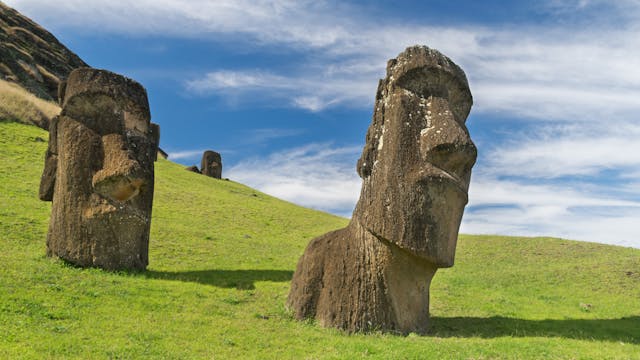
Why were the Easter Island Moai statues built? The Moai statues were built on Easter Island by the Polynesians to embody the spirits of their ancestors, not to appease the gods as their island died.
There are 887 known statues on the island at the moment, but there are more that are still buried and are discovered every now and again. There are also some still in the quarry where they were made that were never finished or moved. The largest of all the statues is still in this quarry.
The Moai have a long face that is carved into a serious expression. They also have a body that is slightly longer than the head. With many of the Moai, the bodies are buried and not visible, but they do all have bodies. The largest standing Moai is 10 meters tall and weighs about 82 tons. The tallest of all the Moai is 21 meters tall and weighs about 200 tons, but it is still in the quarry and was never lifted. The statues were built between 1400 and 1650.
Polynesians called Rapanui colonized Easter Island in about 1200 AD. Easter Island is in the Pacific Ocean, about 3,500 km from Chile. It is a very small island, and it is remarkable that anybody was able to find it. The Polynesians were a seafaring people, and they had many methods of navigating, such as the stars, the winds, and the waves in the sea. The Polynesians that settled the island had probably come from the Marquesas Islands, which is a distance of almost 4,000 km. They brought several crops, chickens, and rats with them. Invasive species that did a lot of damage. If the date of 1200 AD is accurate, and there is a lot of debate about it, then they started to build the statues about 200 years after they landed.
Statues like the Moai are common in Polynesian cultures around the world. They all look slightly different, but the idea is the same. They are used as a container to honor the spirits of ancestors in all of these cultures. The spirits in these statues would help the people left behind. Many of the lands that Polynesian people colonized have volcanoes, and Easter Island was no exception. Nearly all of the Moai statues were made from volcanic tuff, which is a porous stone that forms when volcanic ash cools and solidifies. The statues were very heavy, and moving them wouldn’t have been easy, but certainly not impossible. There are several theories to how they were moved. They could have been dragged on wooden sleds, or rolled on wooden logs. Or, a recent experiment showed that once the statues had been stood up, they could be walked to their location by rocking them from side to side.
There was a theory that the statues were built to appease the gods as life on the islands became harder and harder, but this is not true. The statues were made before life became harder, and the building of the statues actually stopped at the hardest time on the island. The invasive species they brought decimated the local ecosystem, and the Polynesians started to cut down the trees as soon as they arrived to use for building or for firewood. The island is small and there were not a lot of trees to begin with. By 1600, the island was completely deforested, and they had to start growing crops and farming. Deforestation was one cause, but the rats they had brought with them probably ate many of the palm seeds, worsening the situation. They tried to replant trees again, but they couldn’t reforest the island. The farmers grew taro and sweet potato, which became their staple food. They stopped making statues soon after this.
The Polynesians on the island might have continued to this day, and they might have started building Moai again if the Europeans hadn’t arrived in 1722. A Dutch ship discovered the island and stayed for a week. They accidentally started a fight where they shot 10 islanders. Captain Cook arrived in 1774 and reported that most of the Moai had been toppled. Whether that had anything to do with the Dutch and their guns is unknown, but I speculate that it was. The islanders might have felt that the ancestors weren’t protecting them and that they needed a new religion. Their confidence would have been shaken, and there might have been a social psychological shift that caused internal conflicts and war.
When the Europeans came back, they brought their disease with them, as they tended to do. This decimated the island. Then, in the 1860s, more Europeans came and used many of the islanders as slaves, as they also tended to do. The population of the island was decimated. In 1888, the island became part of Chile. It took until 1966 before the Rapanui on the island could escape various forms of slavery and become free. Today, the population is 7,700 peopl,e and tourism is their biggest industry. And this is what I learned today.
Sources
https://en.wikipedia.org/wiki/Moai
https://en.wikipedia.org/wiki/Easter_Island
https://en.wikipedia.org/wiki/History_of_Easter_Island
Photo by Diego Gonzalez: https://www.pexels.com/photo/moai-statues-on-easter-island-chile-14596489/
